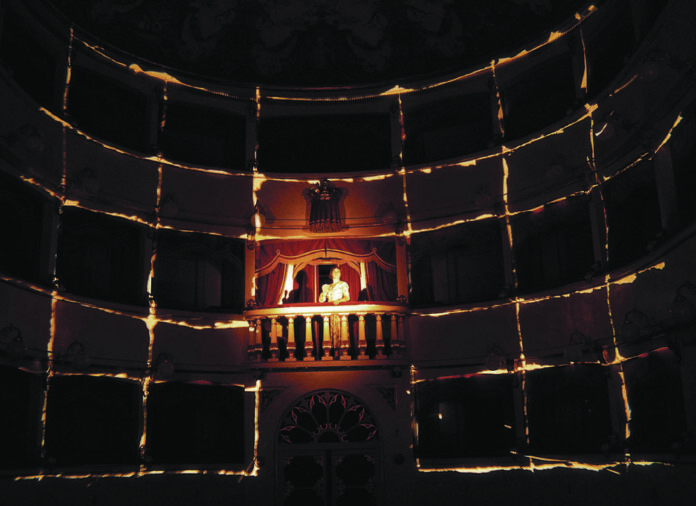In his long international research as a visual artist and theatre director, Fabrizio Crisafullihas received various awards, including, in 2015, an honorary degree in Performance Design awarded by the Danish University of Roskilde. One of his research areas is the project‘Teatro deiLuoghi’ (‘Theatre of Places’). It is based on an operating mode started in the early nineties, and to which he has dedicated some complex self-analyses[1].
The project takes ‘the place’ as the matrix of the show, with a function similar to the one played by the text in theatre. By clearing the field from possible misunderstandings, it should be immediately pointed out that it would be wrong to think of a theatretaking place outside designated buildings. In this meaning, the expression ‘Theatre of places’ designates a practice that can be carried out everywhere, and therefore, also on the stage of an Italian theatre. For this reason, it is a practice far from the experiences that programmatically denied the conventional theatrical venue, such as street theatre or political theatre of the sixties and seventies.Besides, this practice finds methodological correspondences with the site-specific theatre or with the so-called immersive theatre; as well as with activities belonging to contiguous artistic fields, such as environmental art and relational art. In any case, a practice not easily reducible to labels of which, indeed, the artist does not neglect to highlight limits and inadequacies[2].
Alongside better-known aspects of his directorial work, such as the use of light and technology, other fundamental processes of theatrical creation are focused in the “Theatre of Places” project. For example, the relationship with actors, personal and collective memories,space, texts, and dynamics,which govern the reciprocal interaction and the integration of the different elements: motives and reasons which have guided his entire theatrical and installation production. An activity that has always been fuelled, however, by a very close relationship between pedagogy and art.
Born in Catania, a trained architect, with early interests in the relationship between urban planning and theatre, and with over ten years of experience in supporting social and environmental struggles in Southern Italy, Fabrizio Crisafulli has always indulged in his inclination towards observation, understanding of places, stories of inhabitants and their imagery. In addition to his experience, the experimentation conducted in laboratories, created with students from universities and academics of fine arts, should certainly be added. This experience has kept him away from creative dynamics,which normally develop within a working group. Rather, it has also become a training opportunity in the use of essential means. So that, light and technology, elements of primary importance in his artistic work, never have just decorative results.
Significantly, he becomes aware of the same structuring potential of ‘the place’ while preparing the show Il Pudore Bene in Vista. It was presented for the first time in its definitive version on September 4, 1991, at the Teatro della Rocca, in the context of the International Theatre Festival of Fara Sabina.This show was born from the workshops held at the Academy of Fine Arts in Catania and had three female students of scenography as performers.
It is worth dwelling on those circumstances, according to the story of the same author.
In June 1990, the artist and the members of his work group went to Etna in order to make a short film to use in the show. Instead of the place they have in mind for the shooting, they encountered another one: “A sort of ‘ziqqurat’created artificially following the tillage of the surrounding land recovered for cultivation. At the top of the hill, two elements of great strength and archetypal simplicity: a small house, with a gable roof, consisting of a single square-plan body, with a single central door on the front, as in the children’s drawings; and a large maritime pine[3]”. They decided to stop there, without knowing exactly what to do. Both the novelty of the place and the suggestions, inwhich it originates, force them to rethink the solutions proposed in theatre. “It was necessary to abandon, at least temporarily, the tensions and certain principles […] that had guided us up to that moment. To put us in a condition of openness and listening. Through this meditative disposition, in the following days we succeed to bring the place into the work process[4]“.
The definition of “theatre of places” will come later. Firstly, there is the epiphany of the place and the willingness to capture its message. “From that moment on, it was also ‘the place’ that told us what to do. On that occasion, I realized the capacity of the place to provide indications for theatrical work[5].”








